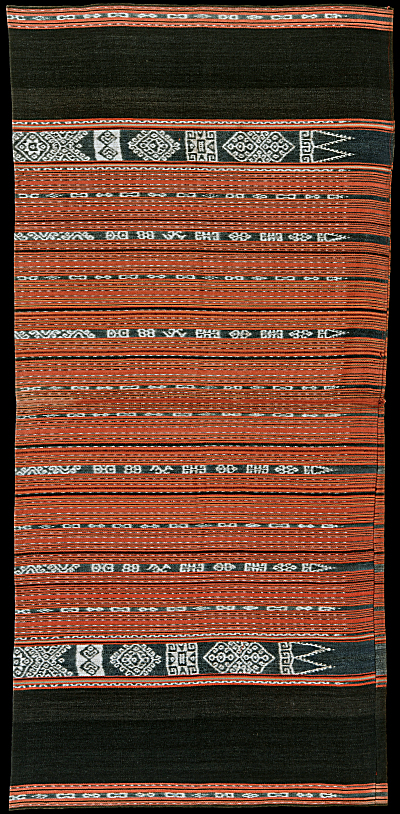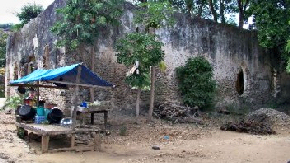| |
 
 | | | |
276 Moluccas, Kisar
Homnon or lavre (sarong)  
| | Locale: | Kisar of Luang. If the former, probably made by Meher (Kisar speaking) people. Overall design is in Kisar style, but palette is that of Luang. | | Period: | Late colonial | | Yarn: | Cotton, hand-spun, medium - plus accent stripes in commercial cotton� | | Technique: | Warp ikat | | Panels: | 2 | | Size: | 71 x 149 cm (2' 3" x 4' 10") LW: 2.10 | | Weight: | 955 g (33.7 oz), 451 g/m2 (1.48 oz/ft2) | | Design: | Classic Kisarese design, with two wide plain indigo bands, two main ikated bands and numerous narrow ikated stripes, some of them in white on indigo, some in white on red. Large base-mounted tumpal motifs serve as finials. The square, boxy motif is an eight-pointed star - an archaic motif with wide distribution in the eastern archipelago and in Turco-Mongol areas of central Asia. Called kota lama, 'old town', by some groups on Timor and Leti who take it to represent Kisar's old Dutch Delfshaven fortress. The lozenge next to it is very similar to the Timorese kaif motif which represents the connection with the ancestors. The colour palette is typically Luang. On Kisar this would be called a homnon, on Luang a lawar or lavre. | | Comment: | This hybrid manifestation of Moluccan art is best described in the words of Brigitte Khan Majlis: 'The question concerning the origins of this sarong cannot be answered with any certainty. The distribution of the narrow and broader warp and ikat stripes on the sarong is usual for both Kissar and Luang. The same is true of the motifs. The very large tumpal shapes, with the clearly-defined feet may be an indication of Kissar on the one hand, but the ikat coloration, namely dark blue, is on the other hand more likely to be found on Luang.' This cloth looks similar to our early 20th c. PC 138, except that the palette has been switched for that from Luang, to very attractive effect. It has all the gravitas of a ceremonial sarong, but conforms to the predominant expression of neither island. Ex collection J.B. Lüth. | | Background: | Chapters on Moluccas and Kisar. | | Exhibited: | Roemer Museum, Hildesheim, 1991. Hong Kong University Museum and Art Gallery, 2017. | | Published: | Brigitte Khan Majlis, Woven Messages, 1991.
Ikat Textiles of the Indonesian Archipelago, 2018.
. | | Compare: | 138 273 274 | | Sources: | Depicted in Brigitte Khan Majlis, Woven Messages, Fig. 312, with attribution Kisar or Luang. Clearly, the author could not place it with certainty either. This particular design is very rare, but not unique. We have seen two similar sarongs over the last four decades. Cf. sarong with similar motifs PC 273. Photo below shows the remains of small fortress Delfshaven, kota lama.
 | | |

©Peter ten Hoopen, 2025
All rights reserved.
|
|


